Active Soil Filter System for Indoor Air Purification in School Classrooms
Abstract
1. Introduction
2. Materials and Method
2.1. School Classroom for Air Purification
2.2. Active Soil Filter
2.3. Experimental Apparatus and Methodology
2.4. Soil Moisture Content
2.5. Analytical Method for the Soil Filter
3. Results and Discussion
3.1. Pressure Loss of the Soil Due to Soil Moisture
3.2. PM2.5 Reduction Performance with Respect to Soil Height and Inflow Air Velocity
3.3. Effects of Soil Moisture on the PM Reduction Performance
3.4. Application and Expected Effect of Active Soil Filter in School Classrooms
4. Conclusions
Author Contributions
Funding
Institutional Review Board Statement
Informed Consent Statement
Acknowledgments
Conflicts of Interest
References
- Qin, H.; Hong, B.; Jiang, R.; Yan, S.; Zhou, Y. The effect of vegetation enhancement on particulate pollution reduction: CFD simulations in an urban park. Forests 2019, 10, 373. [Google Scholar] [CrossRef]
- Park, S.-H.; Ko, D.-W. Investigating the effects of the built environment on PM2.5 and PM10: A case study of Seoul metropolitan city, South Korea. Sustainability 2018, 10, 4552. [Google Scholar] [CrossRef]
- Lin, Y.; Zou, J.; Yang, W.; Li, C.-Q. A review of recent advances in research on PM2.5 in China. Int. J. Environ. Res. Public Health 2018, 15, 438. [Google Scholar] [CrossRef] [PubMed]
- Chen, L.; Liu, C.; Zou, R.; Yang, M.; Zhang, Z. Experimental examination of effectiveness of vegetation as bio-filter of particulate matters in the urban environment. Environ. Pollut. 2016, 208, 198–208. [Google Scholar] [CrossRef]
- Baraldi, R.; Neri, L.; Costa, F.; Facini, O.; Rapparini, F.; Carriero, G. Ecophysiological and micromorphological characterization of green roof vegetation for urban mitigation. Urban For. Urban Green. 2019, 37, 24–32. [Google Scholar] [CrossRef]
- Kończak, B.; Cempa, M.; Pierzchała, L.; Deska, M. Assessment of the ability of roadside vegetation to remove particulate matter from the urban air. Environ. Pollut. 2021, 268, 15465. [Google Scholar] [CrossRef] [PubMed]
- Diener, A.; Mudu, P. How can vegetation protect us from air pollution? A critical review on green spaces’ mitigation abilities for air-borne particles from a public health perspective—With implications for urban planning. Sci. Total Environ. 2021, 796, 148605. [Google Scholar] [CrossRef] [PubMed]
- Martins, N.R.; Graça, G. Impact of PM2.5 in indoor urban environments: A review. Sustain. Cities Soc. 2018, 42, 259–275. [Google Scholar] [CrossRef]
- World Health Organization. Ambient (Outdoor) Air Pollution. Available online: https://www.who.int/teams/environment-climate-change-and-health/air-quality-and-health/ambient-air-pollution (accessed on 22 September 2022).
- Lu, W.; Hackman, D.A.; Schwartz, J. Ambient air pollution associated with lower academic achievement among US children. Environ. Epidemiol. 2021, 6, e174. [Google Scholar] [CrossRef] [PubMed]
- Sunyer, J.; Esnaola, M.; Alvarez-Pedrerol, M.; Forns, J.; Rivas, I.; López-Vicente, M.; Suades-González, E.; Foraster, M.; Garcia-Esteban, R.; Basagaña, X.; et al. Association between traffic-related air pollution in schools and cognitive development in primary school children: A prospective cohort study. PLoS Med. 2015, 12, e1001792. [Google Scholar] [CrossRef] [PubMed]
- Forns, J.; Dadvand, P.; Esnaola, M.; Alvarez-Pedrerol, M.; López-Vicente, M.; Garcia-Esteban, R.; Cirach, M.; Basagaña, X.; Guxens, M.; Sunyer, J. Longitudinal association between air pollution exposure at school and cognitive development in school children over a period of 3.5 years. Environ. Res. 2017, 159, 416–421. [Google Scholar] [CrossRef] [PubMed]
- Kim, J.-H.; Kim, H.-J.; Yoo, S.-H. Public value of enforcing the PM2.5 concentration reduction policy in South Korean urban areas. Sustainability 2018, 10, 1144. [Google Scholar] [CrossRef]
- Pui, D.Y.H.; Chen, S.-C.; Zuo, Z. PM2.5 in China: Measurements, sources, visibility and health effects, and mitigation. Particuology 2014, 13, 1–26. [Google Scholar] [CrossRef]
- Ouyang, H.; Tang, X.; Kumar, R.; Zhang, R.; Brasseur, G.; Churchill, B.; Alam, M.; Kan, H.; Liao, H.; Zhu, T.; et al. Toward better and healthier air quality. Am. Meteorol. Soc. 2022, 103, E1696–E1703. [Google Scholar] [CrossRef]
- Liu, G.; Xiao, M.; Zhang, X.; Gal, C.; Chen, X.; Liu, L.; Pan, S.; Wu, J.; Tang, L.; Clements-Croome, D. A review of air filtration technologies for sustainable and healthy building ventilation. Sustain. Cities Soc. 2017, 32, 375–396. [Google Scholar] [CrossRef]
- Pettit, T.; Irga, P.J.; Abdo, P.; Torpy, F.R. Do the plants in functional green walls contribute to their ability to filter particulate matter? Build. Environ. 2017, 125, 299–307. [Google Scholar] [CrossRef]
- Weerakkody, U.; Dover, J.W.; Mitchell, P.; Reiling, K. Evaluating the impact of individual leaf traits on atmospheric particulate matter accumulation using natural and synthetic leaves. Urban For. Urban Green. 2018, 30, 98–107. [Google Scholar] [CrossRef]
- Meo, S.A.; Almutairi, F.J.; Abukhalaf, A.A.; Usmani, A.M. Effect of green space environment on air pollutants PM2.5, PM10, CO, O3, and incidence and mortality of SARS-CoV-2 in highly green and less-green countries. Int. J. Environ. Res. Public Health 2021, 18, 13151. [Google Scholar] [CrossRef]
- Viecco, M.; Vera, S.; Jorquera, H.; Bustamante, W.; Gironás, J.; Dobbs, C.; Leiva, E. Potential of particle matter dry deposition on green roofs and living walls vegetation for mitigating urban atmospheric pollution in semiarid climates. Sustainability 2018, 10, 2431. [Google Scholar] [CrossRef]
- Perini, K.; Ottelé, M.; Giulini, S.; Magliocco, A.; Roccotiello, E. Quantification of fine dust deposition on different plant species in a vertical greening system. Ecol. Eng. 2017, 100, 268–276. [Google Scholar] [CrossRef]
- Irga, P.J.; Paull, N.J.; Abdo, P.; Torpy, F.R. An assessment of the atmospheric particle removal efficiency of an in-room botanical biofilter system. Build. Environ. 2017, 115, 281–290. [Google Scholar] [CrossRef]
- Irga, P.J.; Abdo, P.; Zavattaro, M.; Torpy, F.R. An assessment of the potential fungal bioaerosol production from an active living wall. Build. Environ. 2017, 111, 140–146. [Google Scholar] [CrossRef]
- Pérez-Lombard, L.; Ortiz, J.; Pout, C. A review on buildings energy consumption information. Energy Build. 2008, 40, 394–398. [Google Scholar] [CrossRef]
- Ascione, F.; De Masi, R.F.; Mastellone, M.; Vanoli, G.P. The design of safe classrooms of educational buildings for facing contagions and transmission of diseases: A novel approach combining audits, calibrated energy models, building performance (BPS) and computational fluid dynamic (CFD) simulations. Energy Build. 2021, 230, 110533. [Google Scholar] [CrossRef]
- Elkamhawy, A.; Jang, C.-M. Performance evaluation of hybrid air purification system with vegetation soil and electrostatic precipitator filters. Sustainability 2020, 12, 5428. [Google Scholar] [CrossRef]
- Farhain, M.M.; Cheema, M.; Katanda, Y.; Nadeem, M.; Javed, B.; Thomas, R.; Saha, R.; Galagedara, L. Potential of developing podzolic soil-based potting media from wood ash, paper sludge and biochar. J. Environ. Manag. 2022, 301, 113811. [Google Scholar] [CrossRef] [PubMed]
- Son, S.; Jang, C.-M. Air ventilation performance of school classrooms with respect to the installation positions of return duct. Sustainability 2021, 13, 6188. [Google Scholar] [CrossRef]
- Lis, P.; Lis, A. The required amount of ventilation air for the classroom and the possibility of air infiltration through the windows. Energies 2021, 14, 7537. [Google Scholar] [CrossRef]
- ANSI/ASHRAE Standards 62.1-2019; Ventilation for Acceptable Indoor Air Quality. ASHRAE: Atlanta, GA, USA, 2019.
- World Health Organization. Roadmap to Improve and Ensure Good Indoor Ventilation in the Context of COVID-19. 2021. Volume 38. Available online: https://www.who.int/publications/i/item/9789240021280 (accessed on 22 September 2022).
- Wu, Y.; Li, H.; Xu, D.; Li, H.; Chen, Z.; Cheng, Y.; Yin, G.; Niu, Y.; Liu, C.; Kan, H.; et al. Associations of fine particulate matter and its constituents with airway inflammation, lung function, and buccal mucosa microbiota in children. Sci. Total Environ. 2021, 773, 145619. [Google Scholar] [CrossRef] [PubMed]

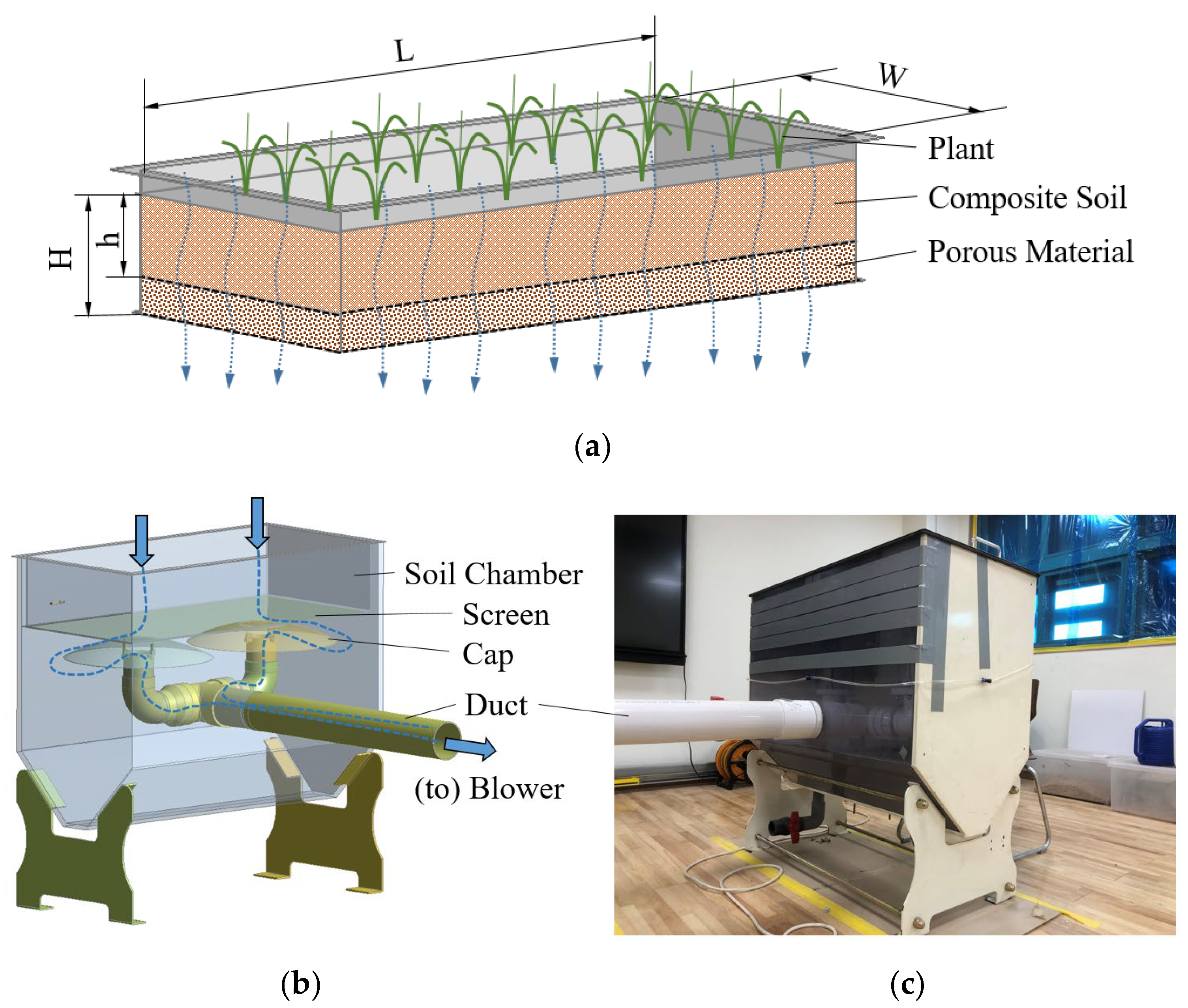

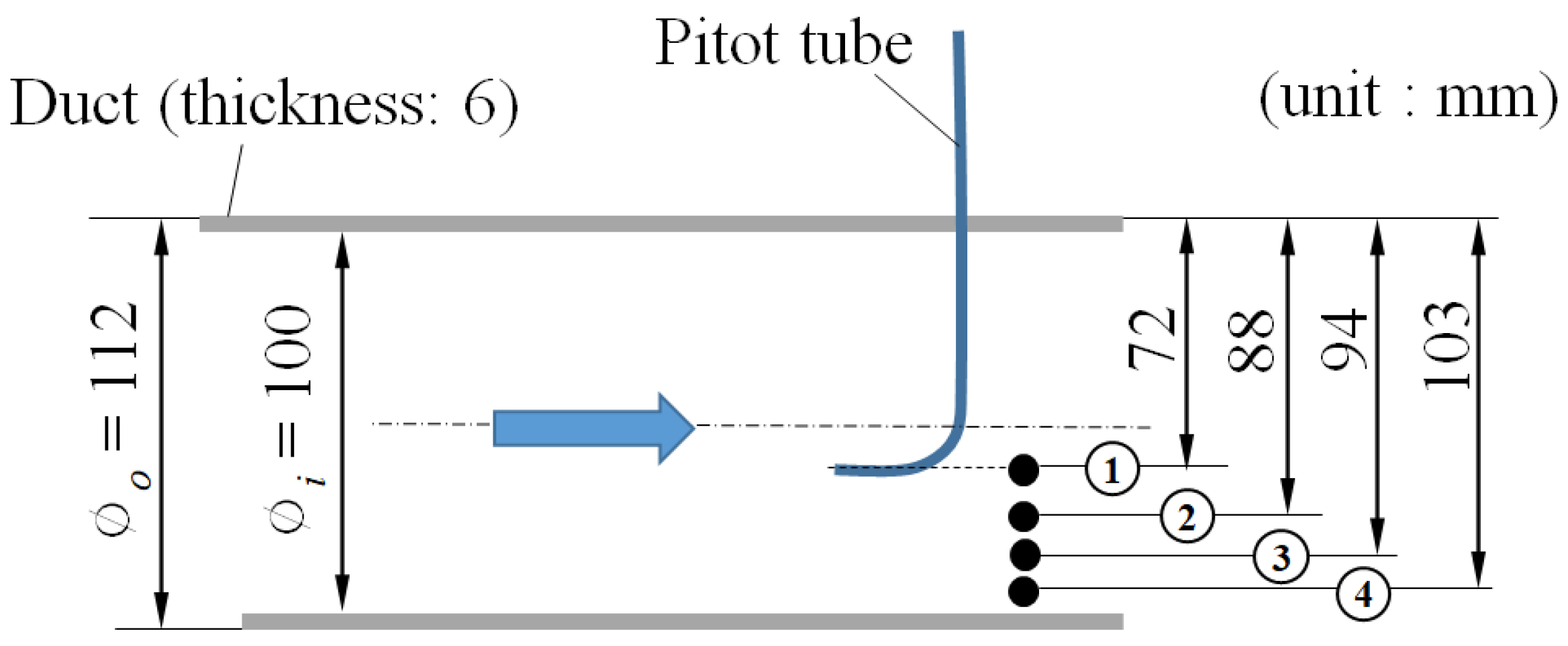


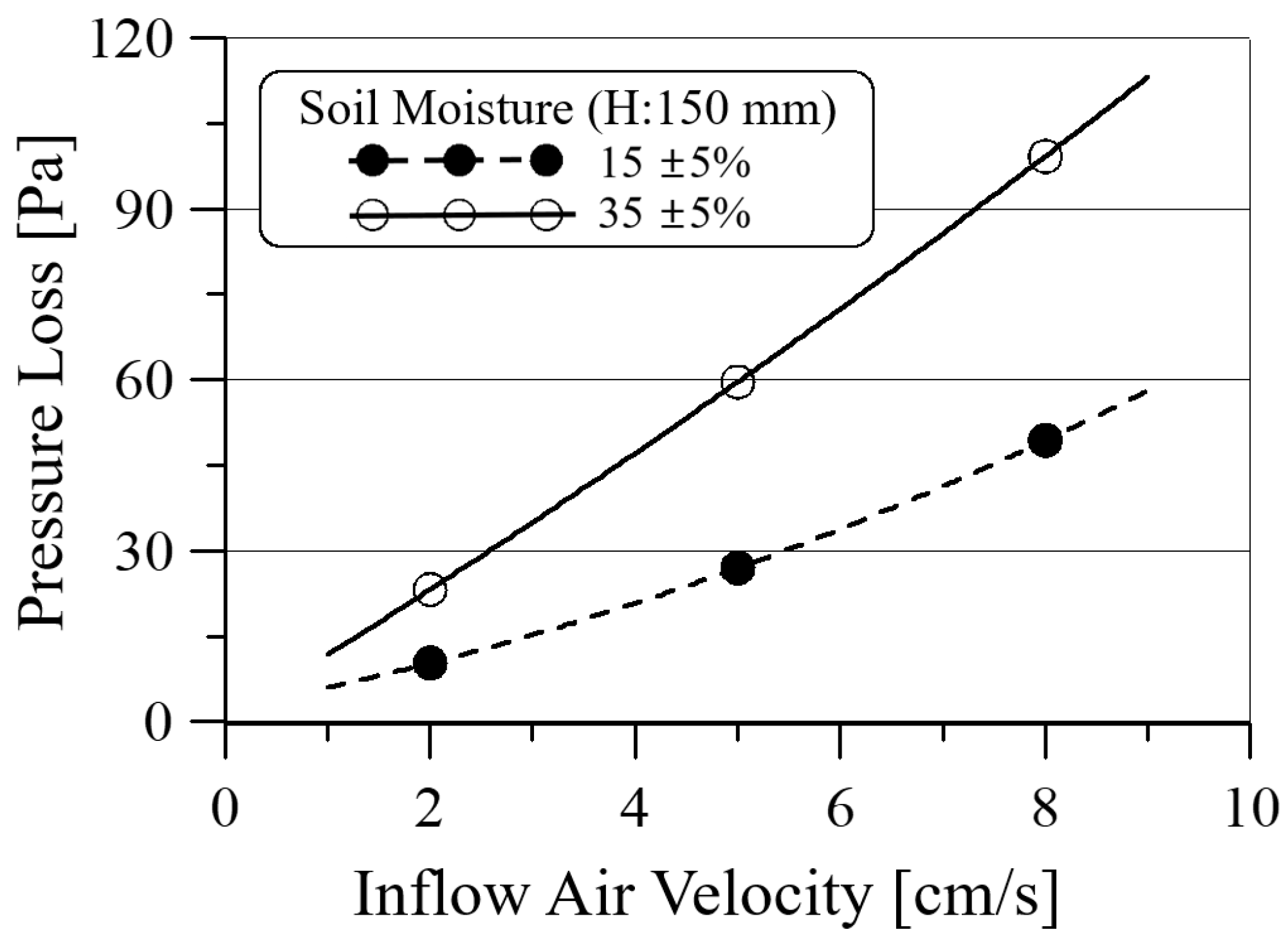


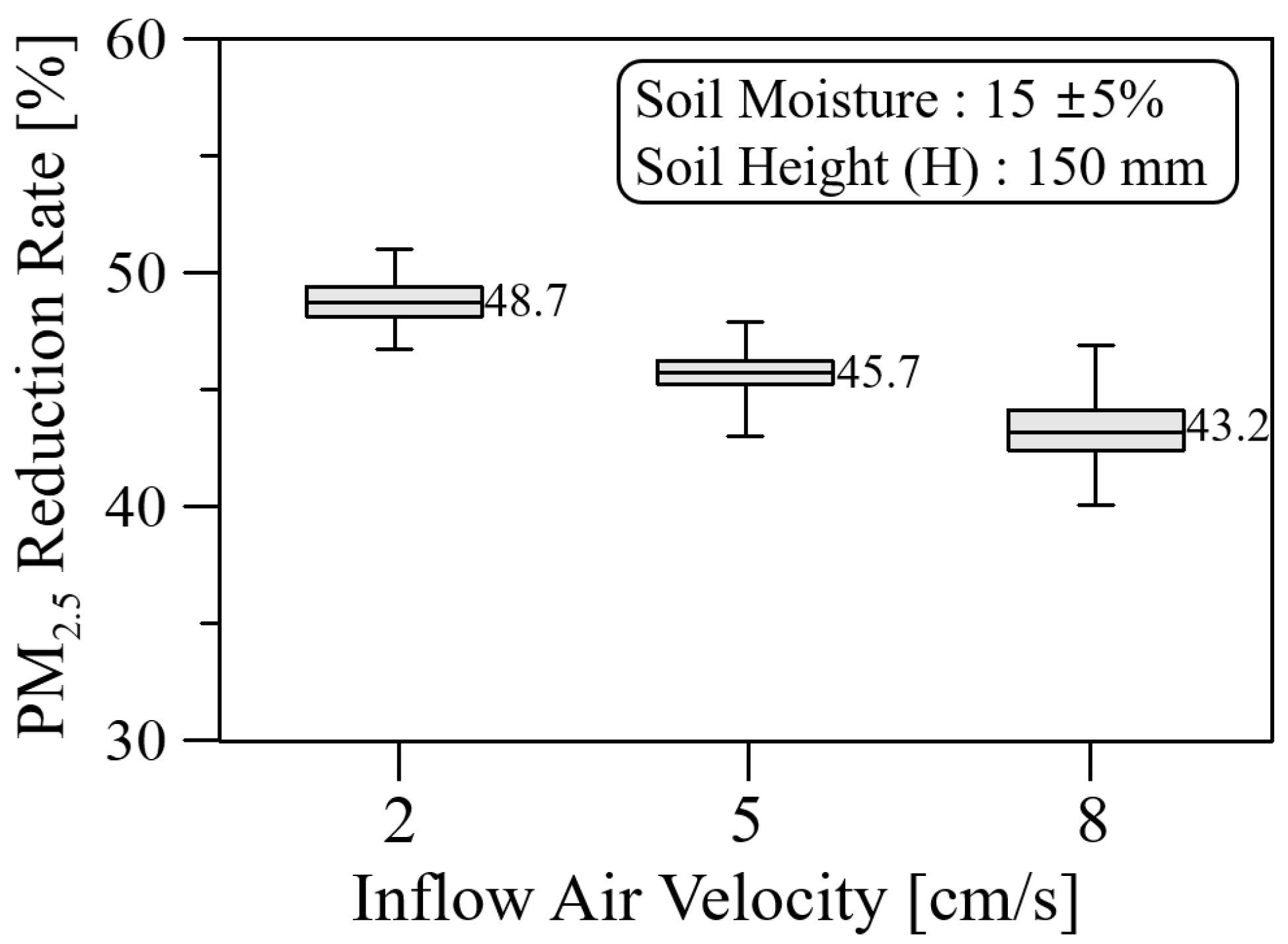

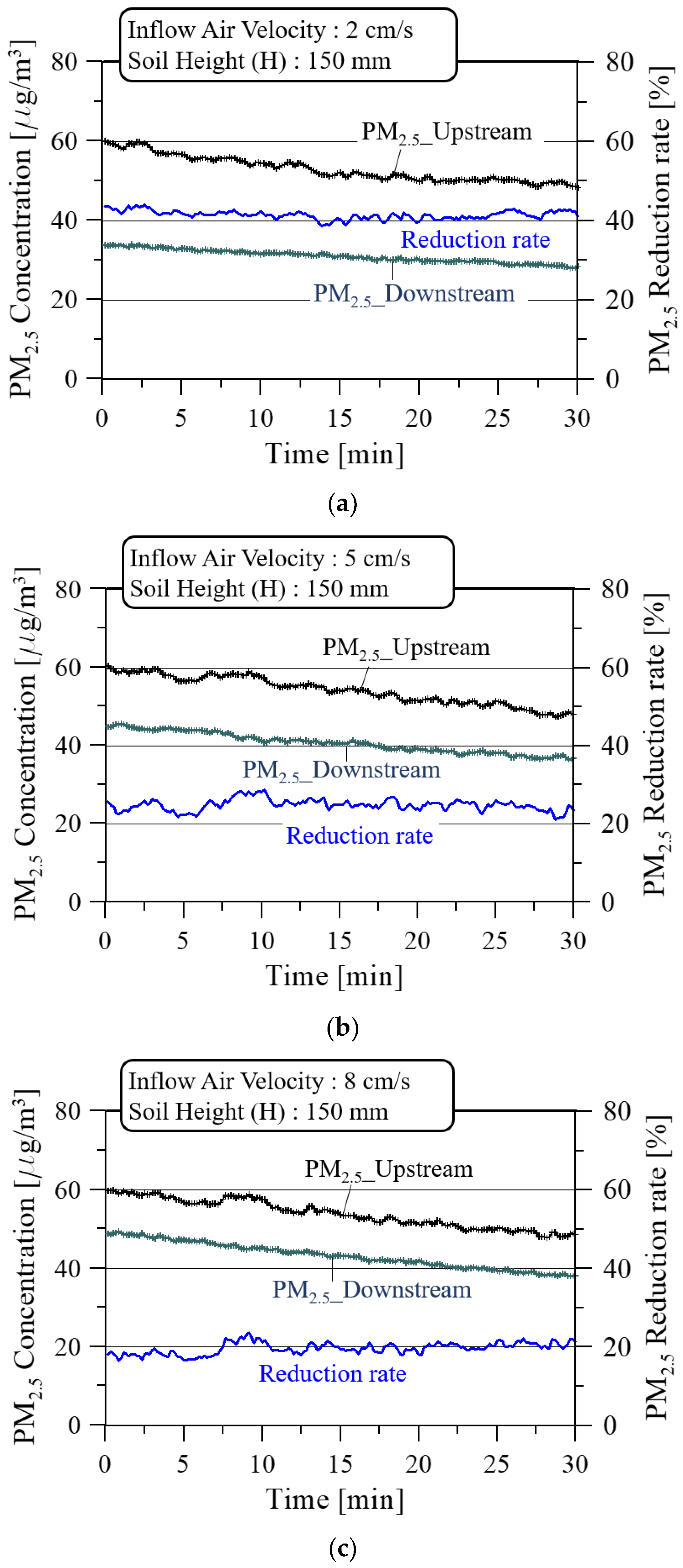
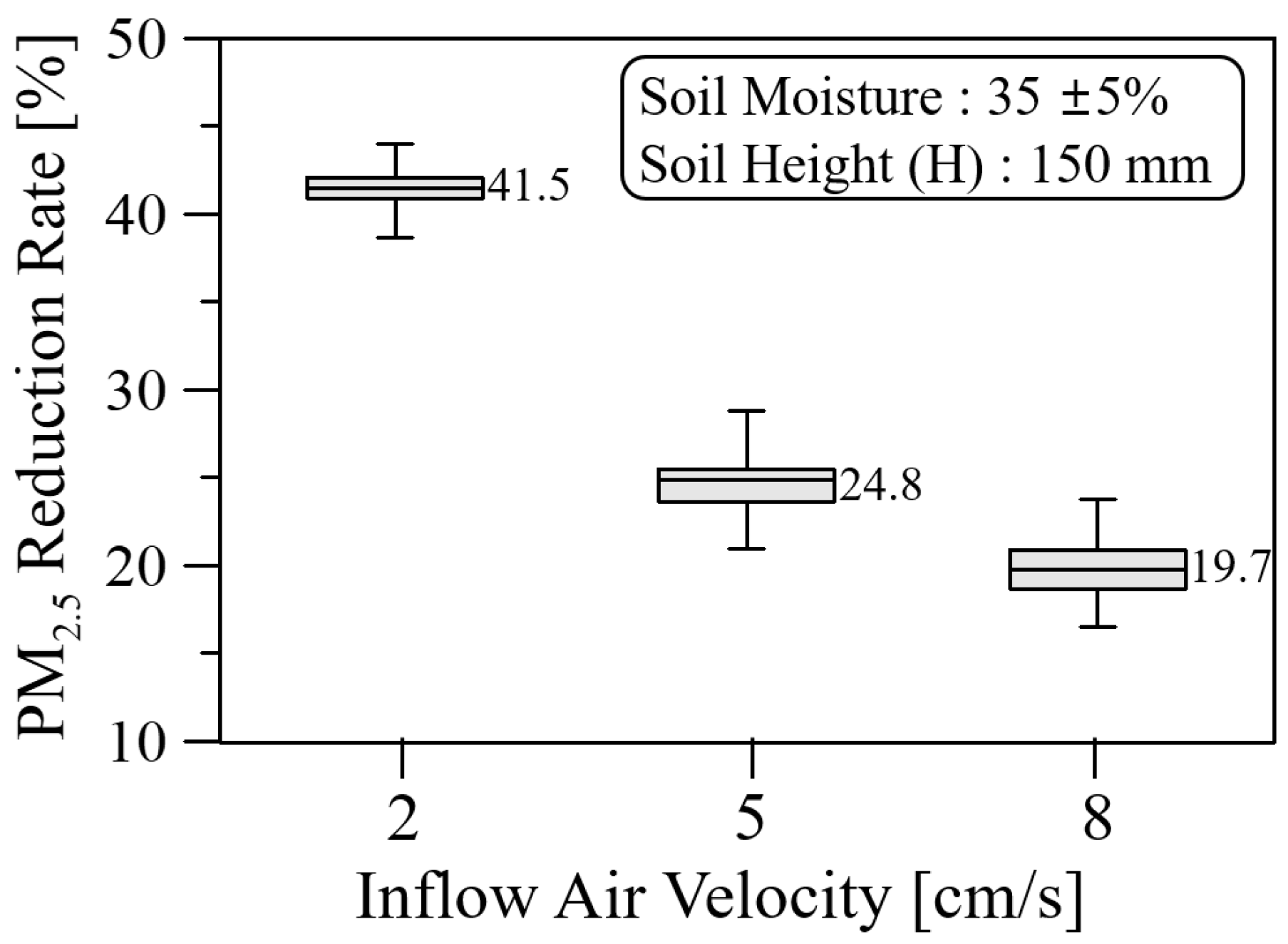
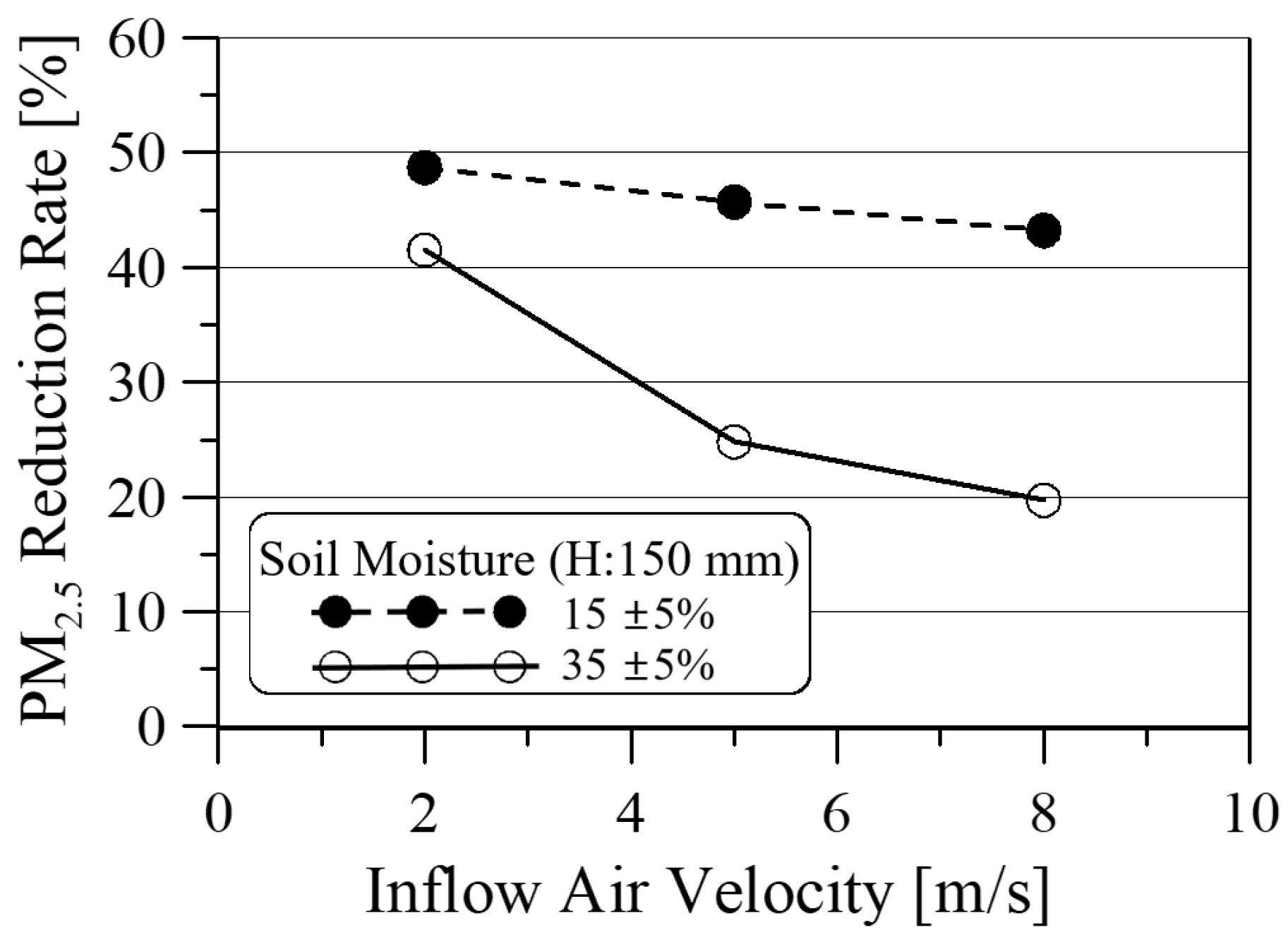
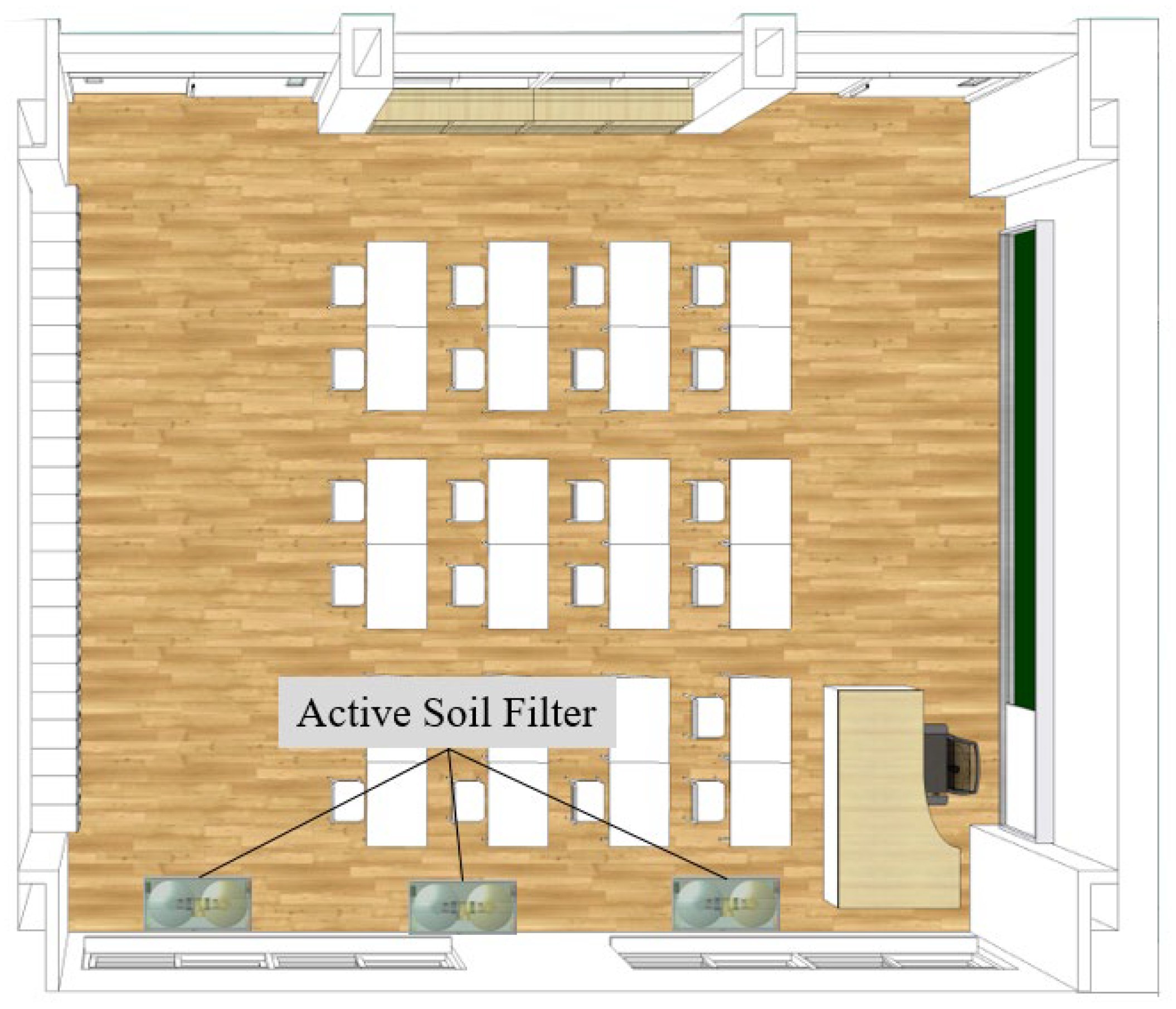
| Parameters | Composite Soil | Porous Material |
|---|---|---|
| Height, mm | 50, 100, 150 | 50 |
| Length (L) × Width (W), mm | 950 × 450 | |
| Material ingredient | Integrated soil consisting of peat moss (10%), red loam soil (30%), broccoli soil (25%), green soil (25%), and perlite (10%) | Hyuga soil (perlite series) |
| Grain diameter, mm | 1~3 | 2.5~5 |
| Picture |  |  |
| Equipment Name | Picture | Specification |
|---|---|---|
| Pitot tube |  |
|
| Micro manometer |  |
|
| Particle matter sensor |  |
|
| Air blower (Inverter) |  |
|
| Soil moisture meter |  |
|
| Inflow Air Velocity, cm/s | Air Suction Hole Diameter, mm |
|---|---|
| 2 | 4.1 |
| 5 | 1.8 |
| 8 | 1.4 |
| Soil Height (H), mm | Inflow Air Velocity, cm/s | ||
|---|---|---|---|
| 2 | 5 | 8 | |
| 100 | 38.2 | 35.1 | 32.5 |
| 150 | 48.7 | 45.7 | 43.2 |
| 200 | 57.6 | 55.3 | 52.0 |
| Inflow Air Velocity, cm/s | Ventilation Volume(A), m3/h | Percent (A/Required Volume), % |
|---|---|---|
| 2 | 92.3 | 22.3 |
| 5 | 230.9 | 55.6 |
| 8 | 369.4 | 89.0 |
Publisher’s Note: MDPI stays neutral with regard to jurisdictional claims in published maps and institutional affiliations. |
© 2022 by the authors. Licensee MDPI, Basel, Switzerland. This article is an open access article distributed under the terms and conditions of the Creative Commons Attribution (CC BY) license (https://creativecommons.org/licenses/by/4.0/).
Share and Cite
Son, S.; Elkamhawy, A.; Jang, C.-M. Active Soil Filter System for Indoor Air Purification in School Classrooms. Int. J. Environ. Res. Public Health 2022, 19, 15666. https://doi.org/10.3390/ijerph192315666
Son S, Elkamhawy A, Jang C-M. Active Soil Filter System for Indoor Air Purification in School Classrooms. International Journal of Environmental Research and Public Health. 2022; 19(23):15666. https://doi.org/10.3390/ijerph192315666
Chicago/Turabian StyleSon, Sungwan, Aya Elkamhawy, and Choon-Man Jang. 2022. "Active Soil Filter System for Indoor Air Purification in School Classrooms" International Journal of Environmental Research and Public Health 19, no. 23: 15666. https://doi.org/10.3390/ijerph192315666
APA StyleSon, S., Elkamhawy, A., & Jang, C.-M. (2022). Active Soil Filter System for Indoor Air Purification in School Classrooms. International Journal of Environmental Research and Public Health, 19(23), 15666. https://doi.org/10.3390/ijerph192315666






